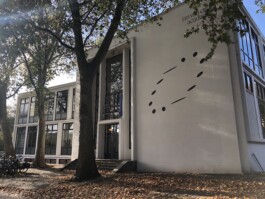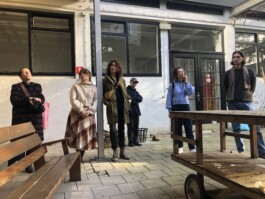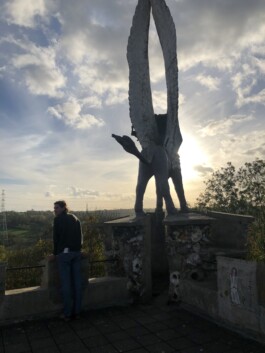Day Trip to Maastricht




Date
November 9th
Jan van Eyck Academie in Maastricht
and Tower Eben-Ezer in Eben-Emael (Belgium)
Border crossers, frontier runners, cross-border commuters – however you want to call the Borderland residents, here is what they do: They live, they work, and they get inspired in an EuRegion where metropolises and rural areas, plain river deltas and soft hills lie right next to each other. In the borderlands, all it takes is one step to cross from one landscape to the next, from one country to another. This is what the group of Borderland Residencies experienced first-hand on their day trip to Maastricht and the neighbouring Eben-Emael in Belgium.


Just a stone’s throw away from the Dutch-Belgian-German border triangle, Maastricht is the political as well as the art capital of the province of Limburg. There is not only the Maastricht Institute of Arts, but also the post-graduate Jan van Eyck Academie that lure artists from all over the world into the city along the Meuse. The concept behind the international art scene in Maastricht is as simple as it is effective: word-of-mouth recommendation that spreads along the globe. Along this year’s Borderland Residencies artist, there are three JVE graduates that represent that international call of Maastricht. Architect-turned-artist Ben Weir from Northern Ireland as well as Mexican artists Amauta Garcia and David Camargo. So while some participants had already become “locals”, other Borderland residents had never been to JVE before and enjoyed the look behind the scenes. In an exclusive talk with Bruno Alves de Almeida, curator of the residency programme at JVE, they got inside-advice for successful applications and how to built a career as an artist.



After spending morning and noon at JVE, the group later set out to their second and final stop of the day: Robert Garcet’s tower Eben-Ezer. In Eben-Emael in Belgium, the self-taught artist built a tower made of flintstone, a natural material of the area. Furnished with biblical and mythical symbols, Eben-Ezer tells a story of Garcet’s life as well as what he considered an alternative history of the earth and human race. According to Garcet, an ancient human civilisation lived in the area of Eben Emael over 70 million years ago. Slowly climbing up the tower, the Borderland artists dived deep into the complex theory behind Garcet's lifework. The extreme concept behind this lifework led to a discussion of how an idea can be carried way beyond what social convention allows. Garcet disrupted the dividing lines between the disciplines of science, history, religion and art. It goes without saying that this not only got him friends, but many critics as well. But however the personal impression and feeling one has toward Garcet's concept: it is an extreme display of a belief, verging on obsession, and as such, a source of inspiration. And it also makes one wonder what is the more challenging task: to physically cross a border between countries or overcoming the borders of convention that each of us carries inside their heads.

